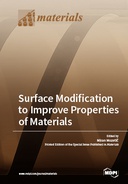Explore

Surface Modification to Improve Properties of Materials
Miran Mozeti?
2019
0 Ungluers have
Faved this Work
Login to Fave
This book contains selected contributions on surface modification to improve the properties of solid materials. The surface properties are tailored either by functionalization, etching, or deposition of a thin coating. Functionalization is achieved by a brief treatment with non-equilibrium gaseous plasma containing suitable radicals that interact chemically with the material surface and thus enable the formation of rather stable functional groups. Etching is performed in order to modify the surface morphology. The etching parameters are selected in such a way that a rich morphology of the surfaces is achieved spontaneously on the sub-micrometer scale, without using masks. The combination of adequate surface morphology and functionalization of materials leads to superior surface properties which are particularly beneficial for the desired response upon incubation with biological matter. Alternatively, the materials are coated with a suitable thin film that is useful in various applications from food to aerospace industries.
This book is included in DOAB.
Why read this book? Have your say.
You must be logged in to comment.
Rights Information
Are you the author or publisher of this work? If so, you can claim it as yours by registering as an Unglue.it rights holder.Downloads
This work has been downloaded 424 times via unglue.it ebook links.
- 152 - pdf (CC BY-NC-ND) at Unglue.it.
- 258 - pdf (CC BY-NC-ND) at res.mdpi.com.
Keywords
- adhesion effectiveness
- adhesive bonding
- adsorption
- Alloy
- Alloy 718
- Aluminum
- aluminum 6061-T6
- aluminum die casting
- anti-bio adhesion
- antimicrobial activity
- antimicrobial film
- atmospheric pressure plasma jets
- Biocompatibility
- Biology
- biomaterial
- bovine serum albumin
- CaF2
- carbonization
- cell cultures
- cellulose thin film
- contact angle measurement
- Corrosion
- dry wear behavior
- duralumin
- dynamic mechanical analysis
- egg shell
- electric field
- electrical stimulation
- electronegativity
- endothealization
- endothelial cells
- epoxy composites
- Etching
- fiber fines
- food packaging
- fretting failure
- functionalization
- functionalization and wettability
- Gold
- gradient nanostructured layer
- Grafting
- grain size
- hardness
- hemocompatibility
- Image processing
- initial surface functionalization
- L. edodes
- laser ablation in liquids
- laser cobalt catalytic probe
- laser synthesis of colloidal nanoparticles solution
- lectin
- low-pressure MW air plasma
- Lyophyllum deeastes Sing
- Materials characterization
- micro-EDM
- microhole-textured tool
- Modification
- mushroom
- nanoparticle-impregnated paper
- nanostructuring
- neutral oxygen atom density
- nisin
- optical emission spectroscopy
- optical emission spectroscopy (OES)
- oxidation
- particle characterization
- physical properties
- Plasma
- plasma polymerization
- plasma surface modification
- plasma treatment
- plasma treatment polyvinyl alcohol
- Poly(tetrafluoroethylene)
- polyethylene granules
- polymer
- polymer polyethylene terephthalate (PET)
- polymer polypropylene
- polystyrene
- porous silicon
- porous-like
- pulse power
- PVD nanocomposite coatings
- residual stress
- self-cleaning fabrics
- sheet forming
- shot-peening
- silicon surface
- silver nanoparticles
- solid state NMR
- special surfaces
- stearic acid
- sulphur hexafluoride (SF6) plasma
- superhydrophobic
- superhydrophobicity
- surface characterization
- surface energy
- surface hardness
- Surface modification
- surface plasmon resonance spectroscopy
- surface properties
- surface residual stress
- surface texture
- surface treatment
- tantalum
- Teflon
- tetrafluoromethane (CF4) plasma
- Thrombosis
- Ti6Al4V alloy
- TIG welding
- ToF-SIMS
- tool life
- tribological performance
- tribological properties
- tribology
- vacuum filtration
- vascular graft
- visible light assisted organosilanization
- wettability
- wetting
- XPS
- zeta potential
Links
DOI: 10.3390/books978-3-03897-797-1Editions


